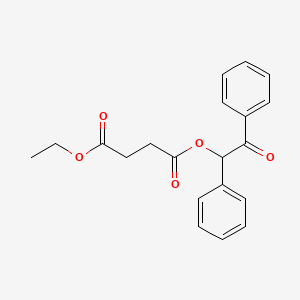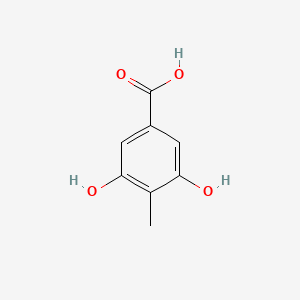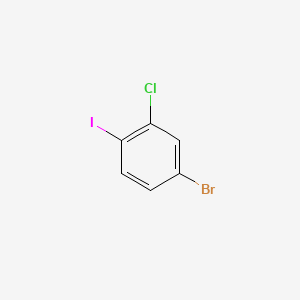
4-Bromo-2-chloro-1-iodobenzene
Overview
Description
4-Bromo-2-chloro-1-iodobenzene is an aromatic compound with the molecular formula C6H3BrClI. It is a halogenated benzene derivative, characterized by the presence of bromine, chlorine, and iodine atoms attached to the benzene ring. This compound is used in various chemical synthesis processes and has applications in scientific research.
Scientific Research Applications
4-Bromo-2-chloro-1-iodobenzene has several applications in scientific research:
Biology: Employed in the synthesis of biologically active molecules and pharmaceuticals.
Medicine: Utilized in the development of diagnostic agents and therapeutic compounds.
Industry: Applied in the production of specialty chemicals, agrochemicals, and materials science
Safety and Hazards
4-Bromo-2-chloro-1-iodobenzene is classified as a hazardous chemical. It can cause skin irritation, serious eye irritation, and may cause respiratory irritation . Safety measures include avoiding breathing dust/fume/gas/mist/vapors/spray, using only outdoors or in a well-ventilated area, and wearing protective gloves/protective clothing/eye protection/face protection .
Mechanism of Action
Target of Action
4-Bromo-2-chloro-1-iodobenzene is a halogenated aromatic compound . It is primarily used as a reagent or intermediate in organic synthesis . The specific targets of this compound can vary depending on the context of the chemical reaction it is involved in.
Mode of Action
The mode of action of this compound is largely dependent on the specific chemical reaction it is used in. As a halogenated aromatic compound, it can participate in various types of reactions, including nucleophilic substitution and free radical reactions . The presence of multiple halogens (bromine, chlorine, and iodine) on the benzene ring makes it a versatile reagent in organic synthesis .
Biochemical Pathways
As an intermediate in organic synthesis, this compound can be involved in the synthesis of a wide range of organic compounds . The specific biochemical pathways affected would depend on the final products of these reactions.
Pharmacokinetics
Like other halogenated aromatic compounds, its absorption, distribution, metabolism, and excretion (adme) properties would be influenced by factors such as its lipophilicity, molecular size, and chemical stability .
Action Environment
Environmental factors can influence the action, efficacy, and stability of this compound. For instance, the rate and outcome of the chemical reactions it participates in can be affected by factors such as temperature, pH, and the presence of other reagents . Additionally, it should be stored in a dark place, sealed in dry, and at room temperature to maintain its stability .
Preparation Methods
Synthetic Routes and Reaction Conditions
The synthesis of 4-Bromo-2-chloro-1-iodobenzene typically involves the halogenation of benzene derivatives. One common method is the sequential halogenation of benzene, where bromine, chlorine, and iodine are introduced stepwise under controlled conditions. For example, bromination can be achieved using bromine (Br2) in the presence of a catalyst like iron(III) bromide (FeBr3). Chlorination can be performed using chlorine (Cl2) with a catalyst such as iron(III) chloride (FeCl3). Iodination can be carried out using iodine (I2) and an oxidizing agent like nitric acid (HNO3) or hydrogen peroxide (H2O2) .
Industrial Production Methods
Industrial production of this compound may involve similar halogenation processes but on a larger scale. The reaction conditions are optimized to ensure high yield and purity of the product. The use of continuous flow reactors and automated systems can enhance the efficiency and scalability of the production process.
Chemical Reactions Analysis
Types of Reactions
4-Bromo-2-chloro-1-iodobenzene undergoes various types of chemical reactions, including:
Electrophilic Aromatic Substitution (EAS): This compound can participate in EAS reactions where the halogen atoms can be substituted by other electrophiles.
Nucleophilic Aromatic Substitution (NAS): The presence of electron-withdrawing halogens makes this compound susceptible to NAS reactions.
Oxidation and Reduction: The compound can undergo oxidation reactions to form corresponding quinones or reduction reactions to form dehalogenated products.
Common Reagents and Conditions
Electrophilic Substitution: Reagents like Br2/FeBr3, Cl2/FeCl3, HNO3/H2SO4, and SO3/H2SO4.
Nucleophilic Substitution: Reagents like NaOH, NH3, and other strong nucleophiles.
Oxidation: Reagents like KMnO4, CrO3, and H2O2.
Reduction: Reagents like NaBH4, LiAlH4, and catalytic hydrogenation.
Major Products Formed
Substitution Products: Depending on the substituents introduced, products like nitrobenzene derivatives, sulfonated benzenes, and alkylbenzenes.
Oxidation Products: Quinones and other oxidized aromatic compounds.
Reduction Products: Dehalogenated benzenes and partially reduced intermediates.
Comparison with Similar Compounds
Similar Compounds
- 4-Bromo-1-chloro-2-iodobenzene
- 1-Bromo-4-iodobenzene
- 2-Bromo-4-fluoro-1-iodobenzene
Uniqueness
4-Bromo-2-chloro-1-iodobenzene is unique due to the specific arrangement of bromine, chlorine, and iodine atoms on the benzene ring. This unique substitution pattern influences its reactivity and the types of reactions it can undergo. Compared to similar compounds, it offers distinct reactivity profiles in both electrophilic and nucleophilic substitution reactions, making it valuable in various synthetic applications .
Properties
IUPAC Name |
4-bromo-2-chloro-1-iodobenzene | |
|---|---|---|
| Source | PubChem | |
| URL | https://pubchem.ncbi.nlm.nih.gov | |
| Description | Data deposited in or computed by PubChem | |
InChI |
InChI=1S/C6H3BrClI/c7-4-1-2-6(9)5(8)3-4/h1-3H | |
| Source | PubChem | |
| URL | https://pubchem.ncbi.nlm.nih.gov | |
| Description | Data deposited in or computed by PubChem | |
InChI Key |
OHHKQBZOURGNLR-UHFFFAOYSA-N | |
| Source | PubChem | |
| URL | https://pubchem.ncbi.nlm.nih.gov | |
| Description | Data deposited in or computed by PubChem | |
Canonical SMILES |
C1=CC(=C(C=C1Br)Cl)I | |
| Source | PubChem | |
| URL | https://pubchem.ncbi.nlm.nih.gov | |
| Description | Data deposited in or computed by PubChem | |
Molecular Formula |
C6H3BrClI | |
| Source | PubChem | |
| URL | https://pubchem.ncbi.nlm.nih.gov | |
| Description | Data deposited in or computed by PubChem | |
DSSTOX Substance ID |
DTXSID10370786 | |
| Record name | 4-Bromo-2-chloro-1-iodobenzene | |
| Source | EPA DSSTox | |
| URL | https://comptox.epa.gov/dashboard/DTXSID10370786 | |
| Description | DSSTox provides a high quality public chemistry resource for supporting improved predictive toxicology. | |
Molecular Weight |
317.35 g/mol | |
| Source | PubChem | |
| URL | https://pubchem.ncbi.nlm.nih.gov | |
| Description | Data deposited in or computed by PubChem | |
CAS No. |
31928-47-9 | |
| Record name | 4-Bromo-2-chloro-1-iodobenzene | |
| Source | CAS Common Chemistry | |
| URL | https://commonchemistry.cas.org/detail?cas_rn=31928-47-9 | |
| Description | CAS Common Chemistry is an open community resource for accessing chemical information. Nearly 500,000 chemical substances from CAS REGISTRY cover areas of community interest, including common and frequently regulated chemicals, and those relevant to high school and undergraduate chemistry classes. This chemical information, curated by our expert scientists, is provided in alignment with our mission as a division of the American Chemical Society. | |
| Explanation | The data from CAS Common Chemistry is provided under a CC-BY-NC 4.0 license, unless otherwise stated. | |
| Record name | 4-Bromo-2-chloro-1-iodobenzene | |
| Source | EPA DSSTox | |
| URL | https://comptox.epa.gov/dashboard/DTXSID10370786 | |
| Description | DSSTox provides a high quality public chemistry resource for supporting improved predictive toxicology. | |
Retrosynthesis Analysis
AI-Powered Synthesis Planning: Our tool employs the Template_relevance Pistachio, Template_relevance Bkms_metabolic, Template_relevance Pistachio_ringbreaker, Template_relevance Reaxys, Template_relevance Reaxys_biocatalysis model, leveraging a vast database of chemical reactions to predict feasible synthetic routes.
One-Step Synthesis Focus: Specifically designed for one-step synthesis, it provides concise and direct routes for your target compounds, streamlining the synthesis process.
Accurate Predictions: Utilizing the extensive PISTACHIO, BKMS_METABOLIC, PISTACHIO_RINGBREAKER, REAXYS, REAXYS_BIOCATALYSIS database, our tool offers high-accuracy predictions, reflecting the latest in chemical research and data.
Strategy Settings
| Precursor scoring | Relevance Heuristic |
|---|---|
| Min. plausibility | 0.01 |
| Model | Template_relevance |
| Template Set | Pistachio/Bkms_metabolic/Pistachio_ringbreaker/Reaxys/Reaxys_biocatalysis |
| Top-N result to add to graph | 6 |
Feasible Synthetic Routes
Disclaimer and Information on In-Vitro Research Products
Please be aware that all articles and product information presented on BenchChem are intended solely for informational purposes. The products available for purchase on BenchChem are specifically designed for in-vitro studies, which are conducted outside of living organisms. In-vitro studies, derived from the Latin term "in glass," involve experiments performed in controlled laboratory settings using cells or tissues. It is important to note that these products are not categorized as medicines or drugs, and they have not received approval from the FDA for the prevention, treatment, or cure of any medical condition, ailment, or disease. We must emphasize that any form of bodily introduction of these products into humans or animals is strictly prohibited by law. It is essential to adhere to these guidelines to ensure compliance with legal and ethical standards in research and experimentation.


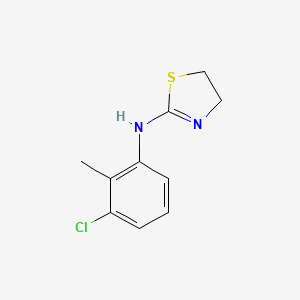
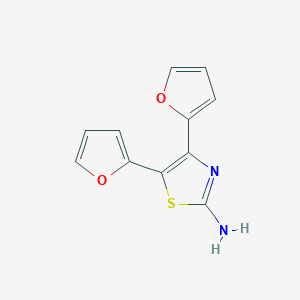
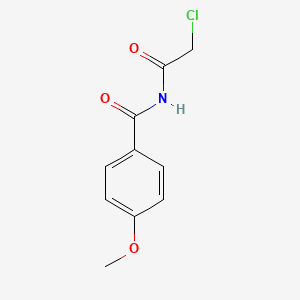


![5-[3-(tert-butyl)-1-(3-methylbenzyl)-1H-pyrazol-5-yl]-1,3,4-oxadiazole-2-thiol](/img/structure/B1333600.png)
